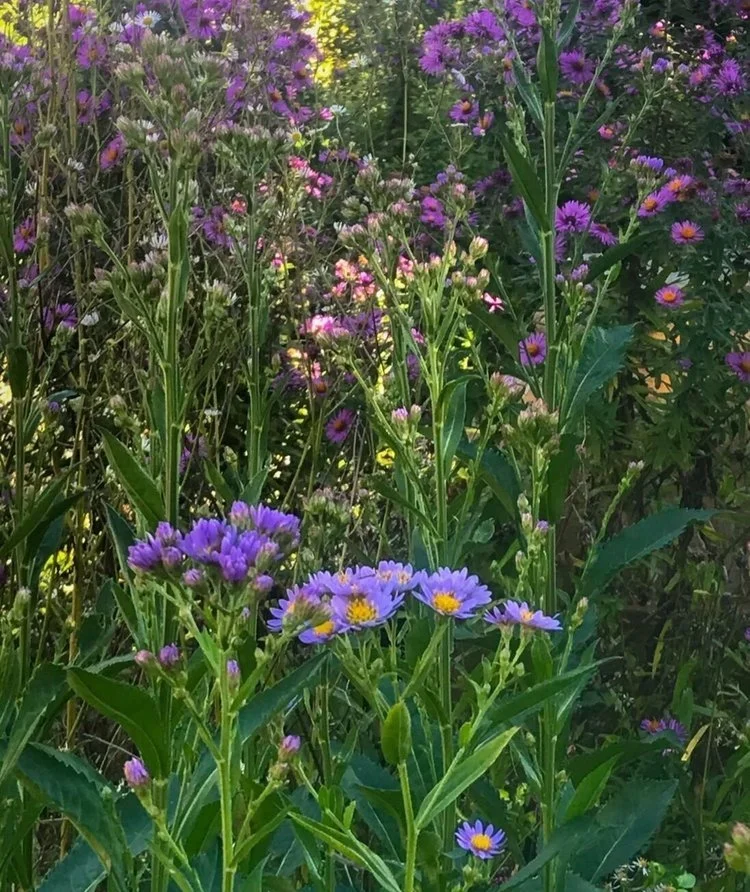JULY
GARDEN TIPS
As the heat ramps up there are many ways to keep your garden looking beautiful. With a few smart strategies, you can keep your plants vibrant and healthy, ensuring a spectacular display late into the season.
*****************
Season Extenders
Want to keep color bursting in your garden as summer winds down? Now's the perfect time to plant late bloomers and season extenders. They'll get established nicely and then light up your landscape when other plants are fading. Consider adding:
Tender Salvias: 'Black and Blue' Salvia guaranitica for deep indigo, Pineapple Sage for a fragrant punch, or Dalvia uliginosa with its charming baby blue flowers.
Classic Fall Favorites: Asters and mums are always reliable. Or Chrysanthemum pacificum for something different.
Salvia guaranitica ‘Black and Blue’
Mums
Asters
What to Prune and When
Say Goodbye to Spent Bulbs: Now is the time to cut back any yellowing daffodil foliage. Remember, leaving it intact for as long as possible is crucial, as the plant uses this time to photosynthesize and store energy in its bulb for next spring's display.
Shaping Perennials: Give asters, chrysanthemums, and other late-summer perennials their final pinch in early July to encourage branching and a fuller form. If some perennials look a bit congested, don't hesitate to thin stems to improve air circulation.
Hard Cuts for Fresh Growth: After their spring flowering, give a hard cut to catmint (Nepeta), lady's mantle (Alchemilla mollis), and perennial geraniums. They'll thank you with a fresh flush of growth!
Nepeta
Nepeta
Container Plants
Container plants are heavy drinkers and eaters, especially in the summer.
Feed Regularly: Opt for compost tea, fish emulsion, or seaweed extract every 7-10 days. These organic liquid feeds provide essential nutrients.
Water Wisely: On sunny, hot days, your containers might need daily watering. We recommend a deep watering once per day, letting the plants "hold" between waterings encouraging them to develop stronger, tougher roots. Only water when plants show signs of wilting.
Weeds & Mulch
Nip Weeds in the Bud: The golden rule of weeding? Catch them before they go to seed! This prevents countless new weeds from sprouting.
Mulch! Add organic mulch to any bare spots or plant another "season extender." Shredded leaves saved from fall cleanup are a fantastic, natural, free, and local mulch for annuals, perennials, and even vegetable gardens. They break down over the season, enriching your soil.
Biennials: Plan for Next Year's Blooms
Get a head start on next year's garden by sowing seeds of biennials now. Plants like foxgloves, Angelica, Salvia sclarea, Lunaria, and Dianthus will produce leaves this year, overwinter, burst into glorious flower next year and set seed their second season.
Foxglove
Lunaria
Verbascum thapsis
Vegetable Gardens
Succession Sowing: Keep the harvest coming by direct sowing succession crops like radish, lettuce, carrots, chard, and beets for your next harvest.
Feed the long season crops: Fertilize heavy-feeding crops such as corn, tomatoes, squash, peppers, potatoes, onions, and eggplant now to support their continued growth.
Smart Watering: Efficiency is Key
Irrigate borders and lawns infrequently but deeply. Generally, gardens and lawns need about 1 inch of water per week, or a deep watering that penetrates 6 inches into the soil.
Monitor Rainfall: Use a rain gauge to keep track of natural rainfall and only supplement with irrigation when truly needed.
Consider Alternatives: Thinking long-term? Consider converting parts of your lawn to lower-maintenance groundcovers, shrub or perennial borders, or even meadow plantings. This reduces water needs and boosts biodiversity!
Echinacea ‘White Swan’
Lobelia Starship Scarlet
Rudbeckia fulgida Goldsturm













































